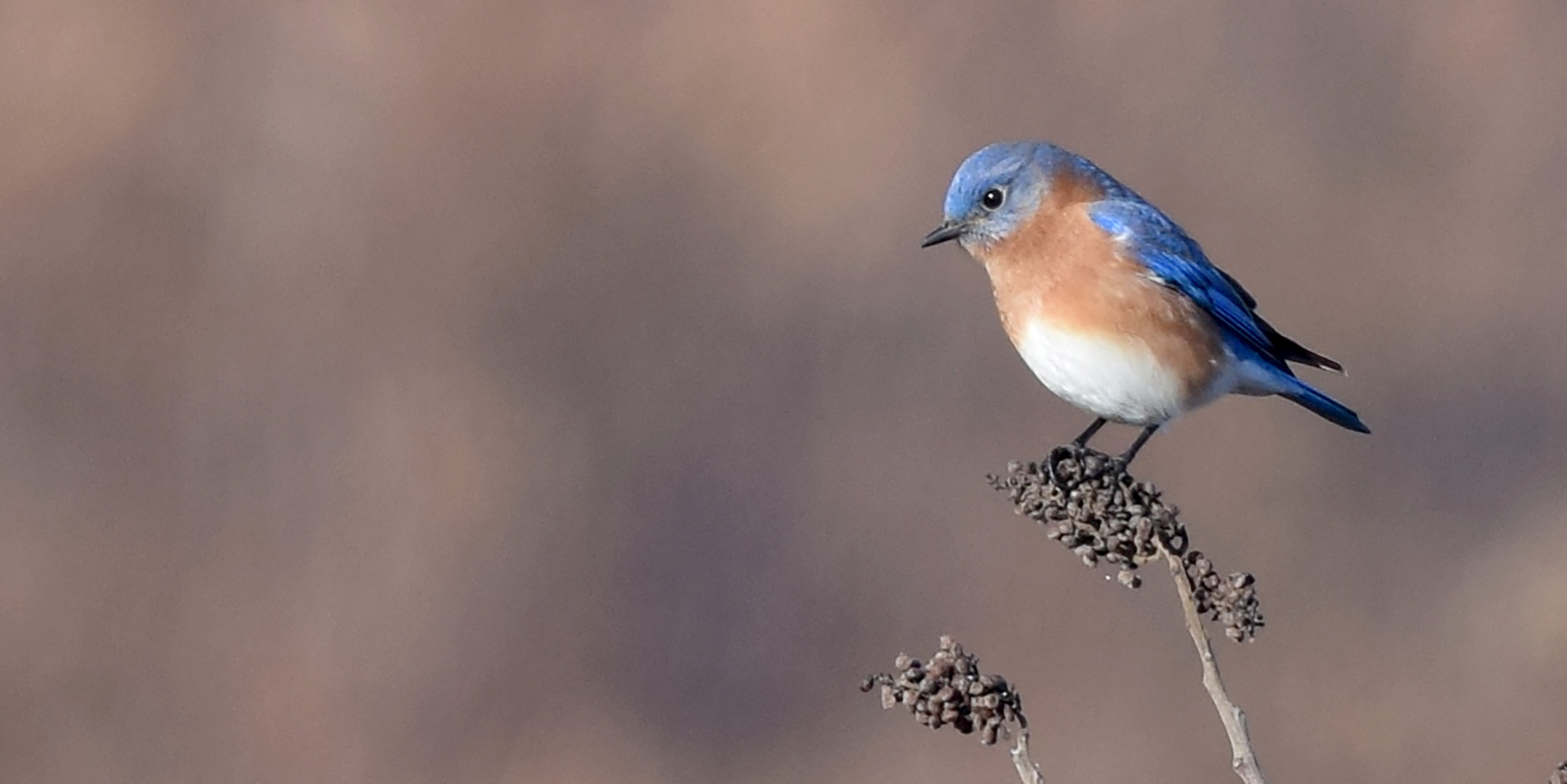Originally published 8 May 1989
If you are looking for the bluebird of happiness, it helps to have neighbors with meadows, hedgerows, fruit trees, organic gardens, and nesting boxes designed especially for bluebirds.
I have such neighbors. My walk to work each day takes me through conservation land administered by the Natural Resources Trust of Easton, Massachusetts. It would be hard to imagine a habitat more perfectly suited to a bluebird’s needs. And there for the past three weeks I have been watching bluebirds, the first in 24 years.
There was a time when bluebirds were as common hereabouts as robins. Then, especially in the 50s and 60s, their numbers took a nosedive. A generation of New Englanders has come to maturity without ever seeing one of these gentle, beautiful birds. For some, the “bluebird of happiness” is a mythical creature, invented by Judy Garland, living somewhere over the rainbow.
But bluebirds are real enough: electric blue, robin-red breasted, plump, round-shouldered insect snatchers, flitting through hedgerows or the branches of a pear tree. Who can see a bluebird and not be happy? The naturalist John Burroughs heard its song as “pur-i-ty, pur-i-ty.” Others hear “tru-al-ly, tru-al-ly.” No one with an ounce of sentimentality in their soul doubts that bluebirds are both pure and true.
Decline in numbers
What caused their decline? Bluebirds are hole-nesting birds; the replacement of wooden fence posts with metal posts and the pruning of dead wood from orchards eliminated many natural cavities, and starlings and house sparrows displaced bluebirds from the few remaining nests. In recent years, friends of the bluebird have set up thousands of nesting boxes all across New England, with holes sized to exclude starlings, and these have undoubtedly assisted the bluebird’s return.
But nesting holes aren’t the whole story. Severe winters took their toll on bluebird populations. Pesticides killed insects on which the birds feed. And of course, at the time of the bluebird’s most precipitous decline, DDT was a likely culprit.
I last saw a bluebird in Easton in 1965. It was the same year I read Rachel Carson’s Silent Spring, published a few years earlier. Carson’s book exposed the massive, indiscriminate use of pesticides, especially DDT, and gloomily assessed the consequences for the environment. Silent Spring was a trumpet of doom and a clarion call to action. It may be the most influential book ever addressed to a popular audience by a scientist.
Rachel Carson was a marine biologist with a bluebird’s disposition. She was not by nature a rabble rouser or a public scold. She would rather have been remembered for her “sea” books, Under the Sea-Wind, The Sea Around Us, and The Edge of the Sea. She did not choose to become a founder of the environmental movement in this country; the issue of chemical pollution chose her.
According to Frank Graham, author of Since Silent Spring, the stimulus for action was a letter to Carson from her friend Olga Huckins. Huckins and her husband maintained a private bird sanctuary behind their home in Duxbury. In 1957 the state began aerial spraying of deadly pesticides as part of a mosquito-control project. The Huckins land was repeatedly sprayed, and many birds were victims.
Those were the days when DDT was sprayed or dusted over half the landscape as a weapon against Dutch elm disease, spruce bud worm, gypsy moths, mosquitoes, and agricultural pests. The more Carson looked into the use of chemical poisons, the more alarmed she became. Her book was a brilliant, impassioned call to arms against entrenched interests in government, agriculture, and the chemical industry.
So successful was her call that within months of the book’s publication many states and foreign countries issued bans on DDT. In 1957 the US Department of Agriculture sprayed 4.9 million acres with DDT; in 1968 the figure had dropped to zero.
Still more poisons
DDT is no longer an issue, but huge amounts of other poisons are still dumped into the environment. Like many of the gifts of science, insecticides and herbicides have the potential for good and harm. Every person will have a different assessment of the benefits and dangers of pesticides, and of the proper level of use for maximum benefit to society.
Carson herself was not opposed to all pesticides. She vigorously opposed long-lasting chemicals like DDT. She suggested that society had embarked upon an unthinking chemical binge, and that silent springs were a high price to pay for the cornucopia of plenty.
One voice of spring now seldom heard is the bluebird’s. The role of chemicals in driving bluebirds toward extinction is debatable, but the coincidence of the bluebird’s rapid decline with the heyday of DDT use is indisputable. Insect-eating birds are easy victims of insecticides.
Agricultural interests with their eye on the bottom line, and even backyard gardeners, are powerfully inclined to use the full arsenal of chemical weapons to increase yields. Everybody wants picture-perfect lawns, healthy trees, and supermarkets stuffed with abundant produce. The chemical industry urges us on with “yes, yes, yes.”
“Pur-i-ty, pur-i-ty,” the bluebirds call. And those who are pleased to see these delightful birds return to our neighborhoods can only answer “Tru-al-ly, tru-al-ly.”



